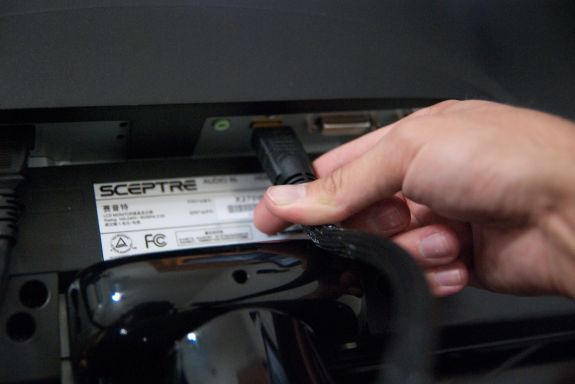Sceptre X270W-1080P Review: A Value 27" That Delivers
by Brian Klug on May 17, 2010 10:22 PM ESTAppearances and Impressions
Out of box, the Sceptre is imposing (though not so much that you’d want to use it as an ornamental staff). That said, there’s no arguing that 27” isn’t monstrous for an LCD display. Packaging is sufficient and of the styrofoam kind - extracting the big panel isn’t a problem, and doesn’t seem to lend itself to being damaged easily.
The display stand is basic - assembly consists of sliding the panel into one piece which then snaps into the circular plastic base. It’s sufficient to hold the display firmly in place, but doesn’t offer any ergonomic options outside of vertical tilt, about 20 degrees is all you get. Keep in mind on a large panel a small amount of tilt feels like a lot because of how much motion there is out at the extreme, but the 20 degrees of travel here lets you get between perfectly vertical, and comfortably tilted upward. There isn’t any height adjustment, swivel, or rotation. The option (tilt) you get is spartan, but the display stand feels firm and works adequately enough that typing on the same desk doesn’t result in some monitor shake starting. That weird kind of monitor tilt resonance can get really annoying, especially on cheaper display stands. There’s a standard 100mm VESA mount, so you can bring your own better stand if you so choose.
Tight Connector Clearance
My only major complaint with the physical design of the Sceptre is that making connectors are given surprisingly little clearance on the back panel. Connecting my relatively chunky dual link DVI cable to the X270W, I had to bend the cable a bit sharply for it to clear the plastic stand. The single link cable supplied in-box has a noticeably smaller connector, so you won’t run into this issue if you use theirs, but be careful if you’ve got some pre-run, fatter DVI-D cables like mine.
Things got a bit worse with the HDMI cables I had on hand, which admittedly have over-engineered cable strain relief and cause all sorts of problems on other displays - these didn’t fit at all and certainly would’ve broken the port inside if I shoved any further. I guess what I’m getting at is that it’d be nice to see a cable management clip or some routing guidance here, and no obstruction preventing you from bringing any cable down and out. At the end of the day, I wound up grabbing some other HDMI cables.
We’ve already talked about the 1080P display resolution and subsequent 16:9 aspect ratio choice. There’s not much to be said other than that 1920x1200 is quickly becoming the exception to the rule, whether you like it or not. For a monitor packing HDMI which will likely be driven at HD resolutions, there’s definitely an argument in favor of 16:9.
The front panel has the OSD controls centered below the Sceptre logo - there are 5 buttons. Four for navigation, one for power. We’ll talk about the OSD menus at the end of the review, but Sceptre’s options are again a bit spartan and just a little confusing - especially for changing volume, but we’ve seen them before.
Power on lag is respectable - from cold boot to 1080P HDMI display in just over 10 seconds. Switching inputs is very fast - nearly instantaneous. The rest of the controls are responsive, though in HDMI mode it does seem like the menus occasionally were a bit slower than over DVI.
Viewing angles are the standard news for a TN panel - very good until you’re viewing the display at an extreme angle. In fact, the only notably bad angle (as with most TNs) is at an extreme negative angle, viewing the monitor from below. Again, that’s to be expected.
All important display quality isn’t perfect out of box, but gets surprisingly good after you calibrate and tune the display’s somewhat outmoded OSD. We did discover one unobtrusive dead pixel, though it seems to come in and out of being a problem.
Overall first impressions are pretty good: The X270W does what it’s supposed to do, and as we’ll see later, does a relatively good job tracking colors and being uniform. It’s a mammoth display, but again dot pitch is a bit bigger than we’re used to.



















61 Comments
View All Comments
HollyDOL - Tuesday, May 18, 2010 - link
I really wonder whether this screen contains true 8bit per channel mask or whether it uses dithering to fake it...Usualy, TN panels are just 6bit per channel and remaining colours are faked using dithering or frame rate control.
Brian Klug - Tuesday, May 18, 2010 - link
I wonder that too, and in all honesty it's likely 6-bit and dithered like you said.I'm still trying to figure out a good way to test - displaying the color pattern works, but there's still some dithering on even the highest end stuff I can find. Still trying to get to the bottom of it.
I'm open to any ideas though! ;)
-Brian
Luke212 - Tuesday, May 18, 2010 - link
the Sony G520 does 1024x768x120Hz. I recently bought one for $20 so i'm sure you can find one to testLuke212 - Tuesday, May 18, 2010 - link
sorry, btw the g520 is VGA not DVI. i also had no luck finding a dvi crt.RavnosCC - Tuesday, May 18, 2010 - link
I needs me some high hrz gaming!Brian Klug - Wednesday, May 19, 2010 - link
They're definitely coming ;) I'm working hard on getting a number of 120Hz panels in for reviewing pleasure ;)Stay tuned!
-Brian
jaydee - Tuesday, May 18, 2010 - link
Count me among those dissapointed in the resolution. That big has got to be at least 1920x1200. I know it's cheap, but would it really add that much cost?I bought a 20.1" Sceptre LCD above 4 years ago (for around $350, ughh...), which I'm overall pleased with. The only thing that bothered me, was really dark scenes, there was a fairly noticable criss-cross of light coming from the corners. I've heard the only way to truly avoid this was to get a LED-backlit LCD. How bad was this on the review unit? I didn't see mention of, but maybe you covered it and I'm just not familar enough with the terminology.
Also, I'd like to see review(s) of some of the ASUS units, namely the VW266h (25.5" 1920x1200 for $250 AR right now) and the above mentioned ASUS MT276HE (27" 1920x1080 for $320 AR).
theoflow - Tuesday, May 18, 2010 - link
Hey Anand and crew,Really digging all the reviews in the past couple of months and it is definitely helping me steer myself in the right direction for product purchases.
Although this might delve into a realm that isn't your speciality, I would be very interested in inexpensive 32" LCD review for HTPC usage. I think this is a sweet spot that is neglected quite a bit, with reviews and suggestions jumping to 42" displays way too quickly.
Keep up the good work and looking forward to whatever is in the review pipeline.
Brian Klug - Wednesday, May 19, 2010 - link
Hmmz, there have been more than a few requests for us to take a look at some smaller (well, is 32" small? Small for a TV, large for a monitor, hehe) TVs and profile them against monitors. I've seen an increasing number of friends dropping their computer-LCDs in favor of LCD-TVs, so I think it'd be an interesting thing to take a look at.It's definitely something we haven't tackled yet. I've got a 32" Vizio of my own (oh boy, the irony of having such nice LCD displays and then two Vizio TVs - though they've improved significantly as of late) that I could try, hmmz. I'll see what I can fit in! Thanks for the idea/feedback!
-Brian
Corporate Thug - Tuesday, May 18, 2010 - link
Anandtech/Brian, can you please please please review the DoubleSight DS-2700DW...I know a lot of people who are interested in seeing ONE review of this thing. I think at $399, it would be a nice comparison.